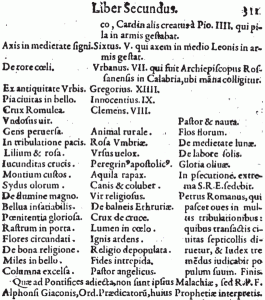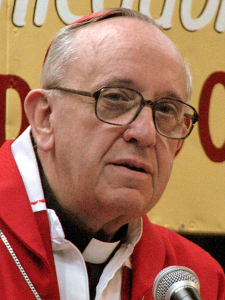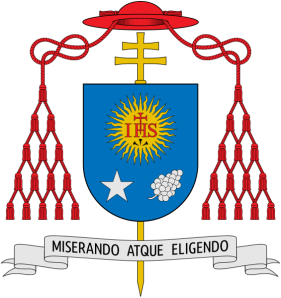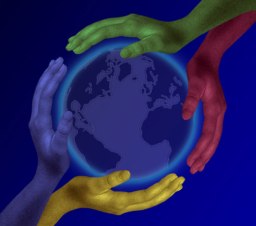On 12 March 2013, 117 Cardinal-Electors – the Papal Conclave – representing every corner of the globe, gathered within the confines of the Vatican’ Sistine Chapel. Their task… to elect the Roman Catholic Church’s new leader, a position vacant since the 28 February 2013 resignation of the erstwhile Pope Benedict XVI.
At 7.06pm on Wednesday 13 March 2013 – after less than 48 hours and three inconclusive ballots – white smoke billowed from the Chapel’s Chimney. A peal of bells accompanied Jorge Mario Bergoglio as he stepped onto St. Peter’s Central Balcony. No longer was he the Archbishop of Buenos Aires. He was now Pope Francis I – the 266th Pope. One also wonders whether Pope Francis was acutely aware of Saint Malachy’s ‘Prophecy of the Popes’ as he cast his shocked gaze upon the worshippers who had gathered in St. Peter’s Square to welcome him into his new position…
“The next Pope (after Benedict XVI) will be the final Pope. He will most likely be an Italian and yes, although not the actual antichrist, he will be very close to antichrist-like in stature.“
My Sister’s words from 2-3 years ago. Was she correct? Actually – in a manner of speaking – she was. As soon as the name ‘Bergoglio’ flashed across the monitor, I turned to look at my Partner. ‘Bergoglio is an Italian surname’, said I… ‘teaches me to doubt her…’, I thought, as I flashed an apologetic smile at her beautiful photo on our living room wall!
The surname ‘Bergoglio’ is an unusual surname, not one evenly distributed across Italy. ‘Bergoglio'(*1) is generally restricted to the Turin-None-Collegno area of the North-Western Italian region of Piemonte (Piedmont). This suggested that the Argentine-born Bergoglio’s family most likely hailed from the Turin location of Piemonte.
Pope Francis’ father, Mario, was, indeed, an Italian immigrant, who had been born in the Asti village of Portacomaro, located approx. 40kms SE of Turin. His Buenos Aries-born mother, Regina, was also born into a family of Piemontese-origin. Whilst Pope Francis was Argentine-born, he is resolutely Italian-blooded.
The 76 year old Pope Francis I is an intriguing choice. Born on 17 December 1936 in Buenos Aires, he is, technically, the first non-European Pope to have held the position of Pope for 1282 years (that position held by Syrian-born Gregory III in 731). He is the first Pope from the Americas. He is also the first Jesuit to have held the position of Pontiff in the entirety of Papal History. The choice of the name Francis (Franciscus) was, said Vatican representatives, was chosen ‘in honour’ of the 12th Century Saint, Francis of Assisi, who had eschewed a privileged life in favour of a life of impoverished, yet spiritual service to God.
Pope Francis I is known for sharing St. Francis of Assisi’s simple approach to life; upon taking the position of Archbishop of Buenos Aires 13 years ago, Bergoglio rejected the luxurious live-in accommodation and transportation offered with the job, choosing to live in accordance with his beliefs – in a small apartment, cooking his own meals, using trains to reach the Office each day.
Internet communities speculate, however, that St. Francis of Assisi may not have been the inspiration of the Papal name, with St. Francis of Xavier and St. Francis de Sales also being proffered as amenable possibilities. Francis of Assisi, Francis of Xavier and Francis de Sales share a common bond – eschewing privileged lives in favour of lives of simplistic poverty in service to God. Francis of Xavier and Francis de Sales, unlike Francis of Assisi, were educated within Jesuit-founded environments.
My knowledge of the Society of Jesus (the Jesuits) is woefully inadequate. I am, however, aware that the Order, founded in Montmartre in August 1534 by Ignatius of Loyola, is regarded with a healthy degree of suspicion. They are frequently referenced as ‘God’s Marines’. Indeed, Ignatius of Loyola, along with co-founder Francis of Xavier, enjoyed militaristic careers prior to their decisions to follow lives of devotion and service to God. Noted astrophysicist and researcher, Susan Rennison (*2), describes the Jesuits as ‘the Roman Catholic Church’s ‘Elite Taskforce’‘. The Guardian‘s Sam Jones addresses the question ‘Who Are The Jesuits?‘ in an eponymous article, found on their website today. I recommend this as a good starting point for any investigations into establishing the Society’s raison d’être.

Upper half of Page 311, detailing the final part of the “Prophetia S. Malachiae Archiepiscopi, de Summis Pontificibus”
FULFILMENT OF ST. MALACHY’S PROPHECY…?
I include myself amongst those who suspected that either incumbent Camerlengo, Cardinal Tarcisio Bertone or current Archbishop of Ghana, Peter Turkson, were the likeliest candidates for the Papal Seat. Common interpretations of St. Malachy’s description of the final Pope included the following:
- He was to be an Italian;
- He was to be an Italian born in Rome;
- He was to be a Cardinal with the actual name of Peter (e.g. Cardinal Peter Turkson).
The final description states ‘In the final persecution of the Holy Roman Church, there will reign Petrus Romanus (Peter the Roman) who will feed his flock amid many tribulations; after which the seven-hilled city will be destroyed and the dreadful Judge will judge the people‘.
There is something we need to remember about the name ‘Petrus Romanus’. According to Roman Catholic teachings, Saint Peter, one of the original Disciples of Jesus Christ, was the Bishop of Rome, Chief Pastor of the Roman Catholic Church. Whilst Saint Peter was never actually an elected Pope, the Roman Catholic Church widely recognises him as their First Pontiff. Every single Pope since Saint Peter, therefore, could be regarded as ‘Petrus Romanus’.
As Wikipedia states, the name Peter is a derivative of the Latin word ‘petrus’, which loosely translates to ‘rock’. The literal translation of ‘Petrus Romanus’, therefore, is ‘The Roman Rock’ or ‘The Rock of Rome’. Again, a title which can easily apply to every Pope from Saint Peter to Pope Francis.
Perhaps we have been taking the translation too literally. Perhaps we should really be concentrating on the substance of the Prophecy as opposed to the identity of the Pope concerned? My Sister’s message concentrated more on the management style and public perception of the Last Pontiff. What does translate clearly is that the Roman Catholic Church is facing a potential battle for survival – and 117 Cardinal-Electors have potentially placed a Crown of Thorns upon the head of its first Jesuit Pope…
Further Interest
(*1) Meaning of the surname Bergoglio: http://www.cognomiitaliani.org/cognomi/cognomi0002er.htm
(*2) Susan Joy Rennison – News of the Imbalance: http://www.susanrennison.com/News_oftheimbalance.php#Latest_News1





